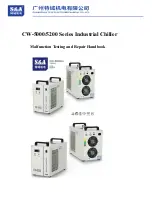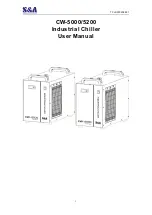
4. Troubleshooting
Procedures for trouble
SMGB0097 rev.0 - 07/2015
127
4
The following table shows efficient checking procedures for trouble.
Fault
Possible Cause
Check/Corrective Action
Compressor stops
on freeze protection
control.
Excessively Low Chilled water Outlet Temperature
Check for excessively low setting of the chilled
water setting knob.
Defective Thermistor
Check for malfunction of the thermistor. Replace, if
necessary.
Shortage of Chilled Water Flow
Check the rotation of the pump.
Air in water Circuit
Purge air.
Compressor stops on
internal thermostat
or discharge gas
temperature control.
High or low voltage, single-phase or phase imbalance Check the power supply line and contactor. Repair,
if necessary.
Excessive Superheat
Check for refrigerant leakage.
Defective Element
Check the contact of the internal thermostat during
the cold condition.
Excessive High Discharge Pressure and Low Suction
Pressure
See
High Discharge Pressure
and
Low Suction
Pressure
.
Insufficient cooling
High Discharge Pressure or Low Suction Pressure
See
High Discharge Pressure
and
Low Suction
Pressure
.
Improper Thermostat Setting
Readjust the setting.
Defective Unload Mechanism
Adjust unload mechanism.
Repair or replace unloaded parts, if necessary.
Noisy compressor
Slugging Due to Liquid Flooding Back to Compressor
Check the superheat of suction gas. Check the
position of Expansion Valve coil. Repair or replace
if necessary.
Worn parts
Check for the sound of internal parts. Replace the
compressor, if necessary.
Miscellaneous noise
Loose Fixed Screw
Tighten the screws of all parts.
Unloaded does not
function
Trouble with the Thermistor
1. Adjust the setting temperature.
2. Replace the thermistor.
Trouble with the Solenoid Valve
1. Check the coil in the solenoid valve.
2. Check oil passage for clogging.
Worn Unloader Mechanism
Check the unloaded system parts in the
compressor.
High discharge
pressure
Defective Check Valve or partially Closed Liquid Line
Valve
Check the valves and strainer. Replace, if
necessary.
Overcharged Refrigerant
Adjust the refrigerant quantity.
Air or Non-Condensable Gas in the Refrigerant Cycle. Purge the gas from the refrigerant cycle.
Suction Pressure is Higher than Standard
See
High Suction Pressure
.
Low discharge
pressure
Insufficient Refrigerant Charge
Add Refrigerant.
Leakage from the Compressor Discharge Valve
Replace the valves. Replace the compressor, if
required.
Suction Pressure is Lower than Standard
See
Low Suction Pressure
High suction pressure
High Inlet Temperature of Chilled Water
1. Check the insulation of the piping.
2. Check the installation specifications.
Excessive Opening of Expansion Valve
Check the position of Expansion Valve coil, or
replace, if defective.
Low suction pressure
Low Inlet Temperature of Chilled Water
Check the installation specifications.
Improperly controlled Expansion Valve or Faulty Valve Check the position of Expansion Valve coil. Repair
or replace, if necessary.
Insufficient Refrigerant Charge
Add Refrigerant.
Excessive Oil in the Water Cooler
Purge Oil.
Scales on Water Cooler Plates
Clean the plates.




































